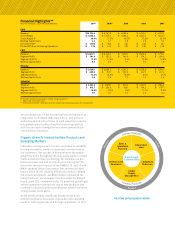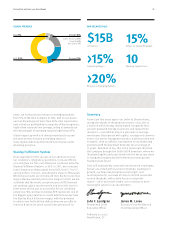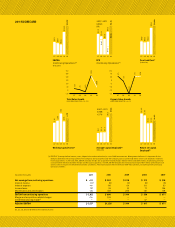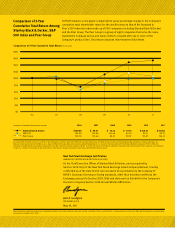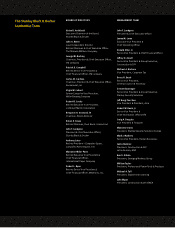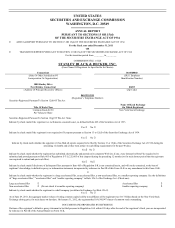Black & Decker 2011 Annual Report Download - page 16
Download and view the complete annual report
Please find page 16 of the 2011 Black & Decker annual report below. You can navigate through the pages in the report by either clicking on the pages listed below, or by using the keyword search tool below to find specific information within the annual report.
4
The professional power tool and accessories business sells professional grade corded and cordless electric power tools and equipment
including drills, impact wrenches and drivers, grinders, saws, routers and sanders. The business also sells power tool accessories
which include drill bits, router bits, abrasives and saw blades.
The consumer power tool business sells corded and cordless power tools sold under the Black & Decker brand, lawn and garden
products and home products. Lawn and garden products include hedge trimmers, string trimmers, lawn mowers, edgers, and related
accessories. Home products include hand held vacuums, paint tools and cleaning appliances.
The hand tools, fasteners & storage business sells measuring and leveling tools, planes, hammers, demolition tools, knives, saws and
chisels. Fastening products include pneumatic tools and fasteners including nail guns, nails, staplers and staples. Storage products
include tool boxes, sawhorses and storage units.
Security
The Security segment is comprised of the electronic security solutions and the mechanical access solutions businesses. Annual
revenues in the Security segment were $2.6 billion in 2011, representing 26% of the Company’s total revenues.
The electronic security solutions business designs, supplies and installs electronic security systems and provides electronic security
services, including alarm monitoring, video surveillance, fire alarm monitoring, systems integration and system maintenance.
Purchasers of these systems typically contract for ongoing security systems monitoring and maintenance at the time of initial
equipment installation. The electronic security business also sells healthcare solutions, which includes medical carts and cabinets,
asset tracking solutions, infant protection, pediatric protection, patient protection, wander management, fall management, and
emergency call products. The electronic security solutions business sells to consumers, retailers, educational, financial and healthcare
institutions, as well as commercial, governmental and industrial customers. Products are sold predominantly on a direct sales basis.
The mechanical access solutions business sells and installs automatic doors, residential and commercial hardware, locking
mechanisms, electronic keyless entry systems, keying systems, tubular and mortise door locksets. The mechanical access solutions
business sells to both residential and commercial customers, with distribution through direct sales, through retailers (including home
centers) and, through third party distributors.
Industrial
The Industrial segment is comprised of the industrial and automotive repair tools, engineered fastening and infrastructure businesses.
Annual revenues in the Industrial segment were $2.5 billion in 2011, representing 24% of the Company’s total revenues.
The industrial and automotive repair business sells hand tools, power tools, and engineered storage solution products. The business
sells to industrial customers in a wide variety of industries and geographies. The products are distributed through third party
distributors as well as a direct sales force.
The engineered fastening business primarily sells engineered fasteners designed for specific applications. The product lines include
stud welding systems, blind rivets and tools, blind inserts and tools, drawn arc weld studs, engineered plastic fasteners, self-piercing
riveting systems and precision nut running systems. The business sells to customers in the automotive, manufacturing, and aerospace
industries, amongst others, and its products are distributed through direct sales forces.
The infrastructure business consists of the CRC-Evans business, and the Company’s hydraulics business. The business’s product lines
include custom pipe handling machinery, joint welding and coating machinery, weld inspection services and hydraulic tools and
accessories. The business sells to the oil and natural gas pipeline industry and other industrial customers. The products and services
are primarily distributed through a direct sales force.
Operating Segments – Other Information
Competition
The Company competes on the basis of its reputation for product quality, its well-known brands, its commitment to customer service,
strong customer relationships, the breadth of its product lines and its innovative products and customer value propositions.
The Company encounters active competition in the CDIY and Industrial segments from both larger and smaller companies that offer
the same or similar products and services. Certain large customers offer private label brands (“house brands”) that compete across a
wider spectrum of the Company’s CDIY segment product offerings. Competition in the Security segment is generally fragmented via
both large international players and regional companies. Competition tends to be based primarily on price, the quality of service and
comprehensiveness of the services offered to the customers.


